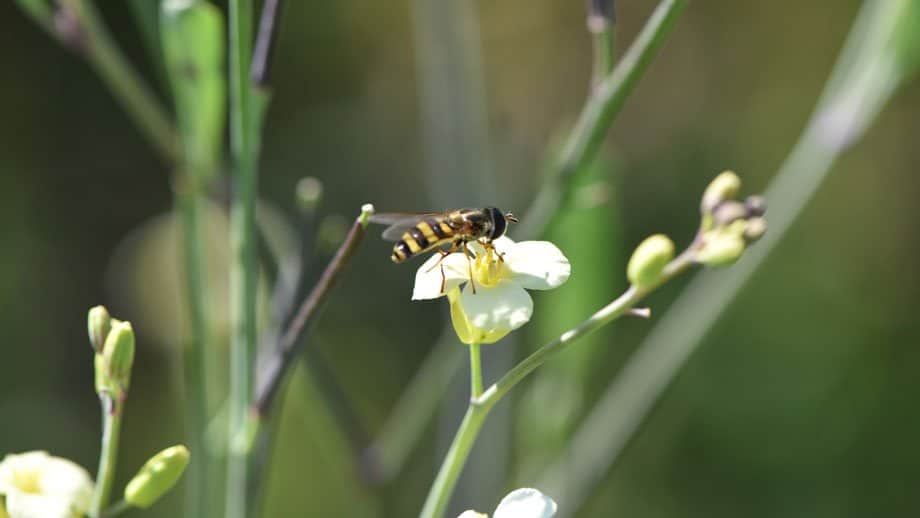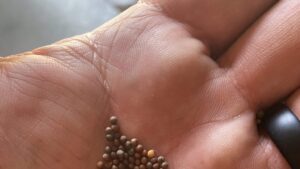When it comes to producing oilseed, the more honeybees and other pollinators that visit a flowering field of Brassica carinata, the better.
This is only one of the insights South Dakota State University researchers gained about the mutually beneficial relationship between honeybees and native pollinators, such as bees, butterflies, moths, wasps and flies, and Brassica carinata, a member of the mustard family.
The oil extracted from carinata seeds can be refined into jet fuel or biodiesel, so scientists want to figure out how to increase seed production, explained Professor Charles B. Fenster, who led the study. He is a faculty member in the Department of Biology and Microbiology in the College of Natural Sciences and a researcher and interim assistant director for the South Dakota Agricultural Experiment Station.
“We are looking at the ecosystem services pollinators provide in an agricultural context,” Fenster says. As bees and other insects gather nectar, pollen grains cling to their bodies and subsequently pollinate other flowers on the same and neighboring plants, improving oilseed production.
On the other hand, the nectar provides fuel for the bees and other pollinators—and for human consumers as well. “When the carinata flowers, it provides important resources for the hives,” he says.
Fenster and his team of one postdoctoral researcher and two graduate students quantified how pollinators affect carinata seed yield and how carinata plants impact honey production and sustain native pollinators. In addition, they looked at how an insecticide seed treatment affects these interactions.
The two-year project was supported by U.S. Department of Agriculture Hatch Act funding through the South Dakota Agricultural Experiment Station and a $140,000 North Central Sun grant from the U.S. Department of Agriculture. Other researchers involved in the Sun Grant project are Director and CEO of Blue Dasher Farms Jonathan Lundgren, SDSU Extension Pesticide Education and Urban Entomology Field Specialist Amanda Bachmann and Civil and Environmental Engineering Professor James Stone and Research Scientist Heidi Sieverding of the South Dakota School of Mines and Technology.
Increasing seed production
“We found that yield is very positively affected by pollinators and the more pollinator visitation we see, the higher the yield of the plants,” Fenster says.
The researchers assessed carinata seed production and pollinators at 36 one-acre plots within a 30-mile radius of Brookings. Cages prevented pollinators from accessing a specific number of plants in each plot. In addition, honeybee hives were added to half the sites.
The researchers identified 28 different species that carry pollen from carinata, according to postdoctoral researcher Henning Nottebrock, who previously worked on plant-pollinator dynamics in South Africa. In addition, he said, pollinators that travel among different plants bring higher quality pollen and increase seed set.
To relate pollinator visits to seed set, the researchers observed each of five 1-square-meter sites within a plot for 20 minutes, counting the pollinators and noting if the insects gathered nectar from flowers within the same plant or different plants.
“We looked at focal plants and counted visits and later harvested the plants, counting the number of seeds per fruit and the number of viable seeds produced,” Nottebrock explains. The seed was viable if it had an endosperm.
“A high number of pollinator visitations can double the carinata seed set,” he says. These results are in agreement with other researchers’ findings on pollinators in canola, which showed a 46 percent seed increase.
Conversely, Nottebrock notes, “When we exclude the pollinators, it significantly lowers seed yield.”
The researchers also looked at the effect of landscape diversity. To do this, they identified the different crops, bodies of water, marginal land and forest within approximately a 2-mile radius of each carinata plot.
“We generally found the greater the landscape diversity around the plots, the higher the seed yield and the higher the insect visitation,” Fenster points out. “That’s interesting from a larger perspective.”
Improving hive health
“We also see that carinata plays an important role in honeybee hive health,” Fenster says. The researchers weighed the hives to determine their health.
“The idea is to provide a variety of resources at different scales to create sugar landscapes,” Nottebrock explains. “These are then consumable resources.” In reviewing the literature, the researchers found no other studies about the resources carinata offer to pollinators.
The research team measured the sugar concentration in the carinata flower nectar using a refractometer. Then they looked at the nectar volume and multiplied it by the number of flowers the plants produced to quantify how much sugar was available for the pollinators.
“Our study is very robust,” Fenster says.
Role of insecticide seed treatments
Insecticide seed treatments, known as neonictinoids, play a complex role in the pollinator-plant relationship, according to Nottebrock. The new treatments, which are designed to protect the plant from herbivores and predators, “work pretty well, but have a heavy effect on pollinators.” Half the study sites were treated with different types of neonictinoids, also referred to as neonics.
“These seed treatments modified plant-pollinator interactions, depending on the scale,” he reports. “When carinata is treated with neonics, the pollinators do not like it.” Other studies suggest that some of the chemical goes into the nectar and pollen.
“Plant-pollinator mediated interactions are affected by two variables—beehives and neonics,” Nottebrock says. In general, carinata can bring new resources into the landscape, providing nectar in the short term and thus attracting more pollinators.
“The ecosystem services pollinators provide add nature-derived benefits for human wellbeing,” Fenster adds.











